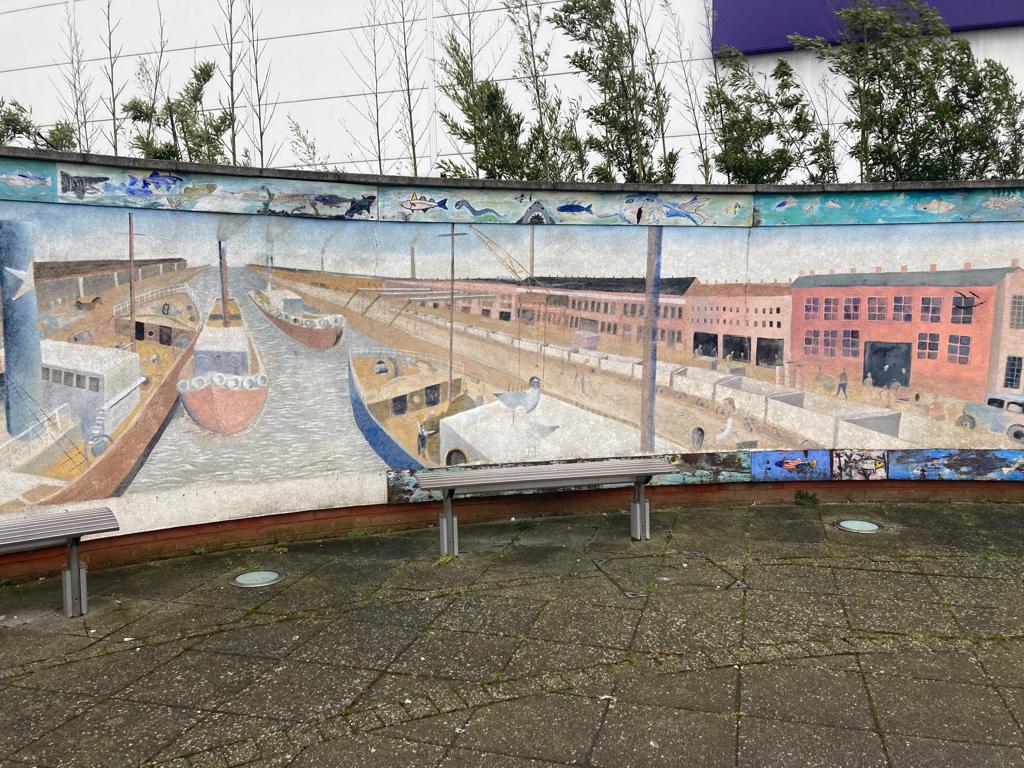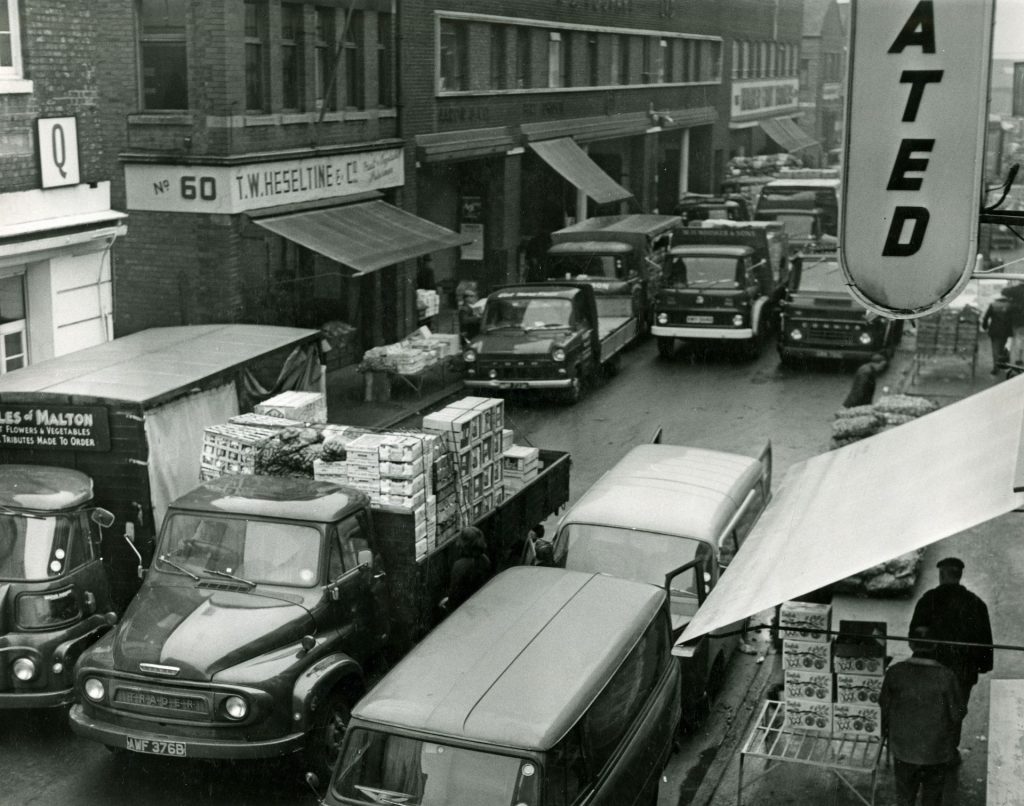Working in Hull, it’s pretty much impossible to undertake a project exploring place, identity, and heritage without thinking about the city’s maritime story. In our latest blog post, Charlotte dedicates a bit of time to sharing some of the memories of Hull’s maritime past (and present) that we’ve collected so far – and shares some personal news about Hull’s maritime future.

A mural on St Andrew’s Quay. Photo by Charlotte.
When I think back over the first twelve months of the Half Life project, there are a handful of key moments that stand out in my memory. In one, I am stood in front of the old Lord Line building, in blisteringly cold February winds and occasional spells of rain, accompanied by members of the local Hessle Road community who are taking me on a walk around the area. It’s the first time I’ve stepped foot on the old fish docks, despite spending lots of time talking about and hearing about them over the course of our project (and of course the past three decades living in the city). This area and this building have become prominent, if continually contested, spaces in Hull’s post-war heritage in recent decades. A symbol for some of ‘who we were’ and ‘who we are’.
Looking out towards the river and along the waterfront, I remember seeing several places that have made up my own life in Hull so far (to the East, the BP towers and the riverfront at Paull, and to the West the Humber Bridge and beyond). I was struck by how many miles of waterfront this city has – as well as all of the different, diverse stories that landscape holds. As I come towards the end of my time with the Half Life project (read on for more on that below), I want to dedicate my last blog post to sharing some of Hull’s maritime history – trawlers, dockers, ‘headscarf revolutionaries’, and beyond.
One of the stories I remember from our oral history series takes us on a similar journey to the one I took that day. In the following passage, our interviewee describes following the same route from West Dock Avenue, through the subway and onto St Andrew’s Fish Docks, in the 1950s and 60s – of course the sights, sounds, and indeed smells they recounted are remarkably different to my own more recent experience.
“Well, when you first went onto the dock, let’s say from West Dock Avenue, the tunnel, it used to be a hubbub of activity without a doubt, there used to be the net people, you know net coming on to the lorries to take to the trawlers. And then as you moved further on outside the different trawlers were offices, the first one used to be St Andrews, you used to get a lot of fishermen just stood outside waiting, in the hope of being signed on, one of the ships what was landing that particular day. Nine times out of ten they was unlucky but occasionally they got signed on. So there was quite a lot, you used to go down every morning, till about half past eleven, twelve o’clock, till all the ships was signed up and then you went down again the next morning in the hope – like a casual worker really.
But that was the fishermen. Now in between all this lot, there’s a lot of, err, like what we used to call the ‘shore gang’. They used to be loading lorries up, and taking em’ to the ships with bobbins and nets and fishboards and all the, rigmarole of a trawler you see. And then the ships used to go down and further down the dock opposite, err, well not opposite it’s difficult to explain but about half way down the dock there used to be the ice house, used to be these big trunks going across with pipes going down into the fish rooms to fill ‘em with ice, and a bit further along there was the coal bunkering, these trains used to come up and tip the coal and then they used to tip the coal into the bunkers in the trawlers, all this was activity. This used to happen to every trawler within a 30 or 48 hour period, between arriving to land to going back to sea. So you can imagine what it was.”
Others have similarly recalled the experience of going onto ‘fish dock’ when talking about Hull’s maritime story:
“Can you tell me what you would have seen and what it was like?
Oof, trawlers, trawlers and trawlers [laughs]… You know you’d see the trawlers coming in, going out, depending what time tide time was. You’d see a lot of the kids saying ta’ra to their Dads, going to sea, I think Dad had an uncle who was on the trawlers, dint’ really know him, we used to come off there and go see my Auntie. She used to have a shop down Eton Street, at the bottom end. Go get some sweets.
But yeah I mean, the docks themselves, bloody hell, you had your dry side and your wet side. So if you had a walk around the wet side well you’d see bloody fish like that [gestures a big fish and laughs], and it’s always busy you know there’s always som’et going on, welders and all, whatever, and then people putting the gear on board to go away, and people coming home, getting the gear took off. And they used to go down to settle, get the wages and that, then they used to come off there and go in Rayner’s, or nearest pub, there used to be lots of pubs down here.”
These vivid descriptions of daily life on Hull’s fish docks are unsurprising, a reflection of the importance given to this element of Hull’s maritime story in the heritage discourses of the city. They’re certainly the type of story we’ve been told most frequently (perhaps even more so than we expected), although our project has also managed to capture a range of stories of other parts of Hull’s maritime past. For example, recollections of East Hull ‘dockers’, of ‘bargees’ on the River Hull, and of the older city-centre docks like Princes Dock and even Queen’s Dock have also come to light:
“As a child I remember my uncle, one of my uncles, was a port policeman and he would take us to the docks, he would get us in on the docks, again it wouldn’t happen now would it? [laughs]. “We’ve just brought the family on the docks it’s fine!”, but we’re all going on, and we used to watch – I remember seeing the banana boats coming, but nothing’s every talked about that, the banana boats…and I remember the timber ships.”

Humber Street. Photo courtesy of our project partners the Hull History Centre.
As seen in the quotes here, these stories are often acknowledged as lesser-told tales of Hull’s past – stories that people feel need more recognition, research, and celebration.
“I always thought that there was little said about the erm, the barge world and the Humber and the vessels, compared to the trawlers. You know, Hull, people always talk the trawlers and the lost, I think it was three trawlers went down in one winter, and they always talk about that but they never talk about things about the barges.”
It’s been clear in our research that major projects taking place in Hull over the past few years, such as Hull’s year as UK City of Culture or Hull Maritime, have played an incredibly important role in people’s perceptions of maritime heritage, both in terms of how significant people consider it to be, and which sorts of stories are told. In fact, we’ve noticed how many stories (or versions of stories) that we might now consider key parts of Hull’s ‘authorised’ or ‘official’ story – such as that of ‘Dead Bod’ or the headscarf revolutionaries’ – have only become prominent very recently:
“…the story of Lily Bilocca [sic] is amazing and I didn’t know anything about that as a child. Not a thing…and when we bounced all those pictures off the City Hall and the side of The Deep, that’s when I learnt about migration to Hull, it was the City of Culture when they did the video show on the side of The Deep, and they showed you all the stories of immigrants coming into Hull, just amazing.”
For some people this growing recognition is an important part of remembering those who have been lost in Hull’s maritime industries, particularly in relation to deep-sea trawling, and especially the ‘Triple Trawler Tragedy’. Stories of a maritime past are often coupled with a strong desire to protect and preserve this heritage for years to come, and varying degrees of hope and optimism for the future:
“I think [future generations] should know about their heritage. And if we don’t speak about it and do something about it it’s gonna be lost forever. I mean I think the Maritime Museum is doing wonderful with what’s happening there, they’re doing a really good job.”
For others, the importance of Hull’s maritime story is part of a broader understanding of what it means to be from the city – and perhaps an even stronger feeling that maritime history is an integral, fundamental, elemental part of Hull’s communities, in the DNA of the place:
“And I think, I’ve had conversations with people before from Hull that have said, you know we are, we are water people, we are people that have you know come from a long line of seafarers and fishermen and you know dockers, and that sort of thing. So we are, we are water people, we are people that have connection, err, whether we realise it or not it’s in us, genetically, through our ancestors…and I think when you strip everything back and you go back to that, you know if you’re a Hull person born and bred, that’s in you somewhere.”
Returning to the moment I remembered at the start of this blog post, stood on the edge of the river next to the Lord Line building, looking East and looking West, I am reminded of a conversation I had with another of our interviewees later in the year. In the following passage, this interviewee describes their own ritual of going to the river – this time at Hull’s Victoria Pier – to reflect on that connection to water, and the way it’s shaped the city’s past:
“I love going onto the pier, cos you get, you get the geography of the city when you go to the – you can see the Humber Bridge on one side of Hull and BP and Salt End, you can see all the city, you see how big the city is when you go down to the waterfront, the pier…the one thing, the one that I emphasise all the time is about it being a port, always been a port, always, like the dock offices, the docks, um, the Humber when you see it and the River Hull. All that’s connected…that’s Hull’s history isn’t it.”
And returning to my own journey, it’s time to announce that later this month, I’ll be leaving the Half Life of the Blitz project to join the team at Hull Maritime. Over the past year it’s been an enormous privilege, and an enormous pleasure, to spend time with people and communities all over the city, sharing stories of Hull’s maritime heritage – and lots more besides. I’m thrilled to be continuing that work, albeit in a different setting, as part of the wonderful Hull Maritime project from September.